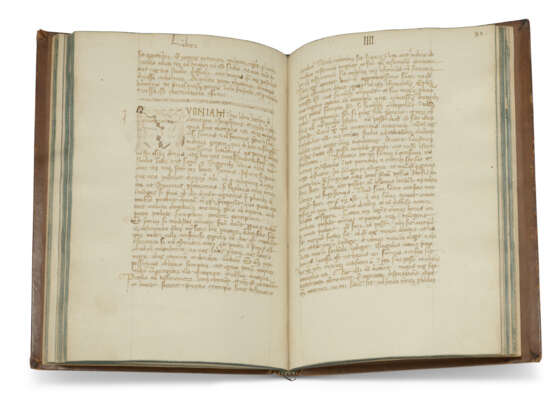ID 1514366
Lot 23 | Ps. Cicero
Valeur estimée
£ 4 000 – 6 000
De rhetorica, in Latin, manuscript on paper and vellum [Italy, Lombardy, possibly Bergamo], dated 21 November 1465
An attractive example of one of the most popular texts of Italian Humanist learning, the De rhetorica historically attributed to Cicero, the present copy signed and dated by the scribe Jacopo Maffei.
c. 210 x 140mm, iii + 54 + iii leaves, collation: 110, 2–312, 413 (of 14, lacking xiii), 55 (of 10, lacking i, the final two leaves cancelled blanks), the outermost bifolium of each gathering vellum, otherwise paper, modern pencil foliation 1–54 followed here, superseding a medieval foliation in ink, 1–56, from which ff. 47 and 49 are missing, catchwords survive, 33 lines written below top line in neat Humanistic script, ruled space: c. 150 x 85mm, the first word of each section in majuscules, paraphs in pale red, with blank spaces for rubrics and coloured initials, running headings ‘[Liber] I’ – ‘IIII’ (lacking 2 leaves after ff.46 and 47, occasional staining and cockling). Bound (for Drury?; see Provenance) in polished brown 19th-century English leather, the covers framed by a single gilt fillet, the spine lettered vertically in gilt capitals ‘Ciceronis Rhetorica. MS. in membr: Sec: XIV.’ (somewhat scuffed, some damage caused by adhesive tape, the front board detached).
Provenance:
(1) Written by the scribe Jacopo Maffei, son of Giovanni de’ Maffei, on 21 November 1465: his colophon on f.54: ‘Opus istud rhetoricorum novorum M. T. Ciceronis consumatum fuit in nimbro (?) per me Jacobum M. Johannis de Maffeis de Zonio [i.e. Zogno, to the north of Bergamo], die xxj Novembris. Anno domini nostri Millesimo quadringentesimo sexagesimo quinto. Indictione tercia decima. Laus deo.’ The Maffei are an ancient family, which, in the 15th century, had branches in Volterra, Rome, Verona, and elsewhere. The paper watermarks are not clearly visible but appear closest to Briquet nos. 3039–51, supporting a localisation in northern Italy.
(2) Unidentified 16th-century Italian owner: semi-legible inscription, perhaps ‘Rhetorica est aliquid [...] forma questive(?) [...]’, f.54v.
(3) Henry Drury (1778–1841), Classical scholar, bibliophile, and master of Harrow school, where he was tutor (and later friend) of Byron: his characteristic ownership inscription on f.ii.
(4) Henry Ellis Allen (1808–1874): his ‘Henrici Alani’ bookplate (de Ricci, English Book Collectors, p.189), and a label with the number ‘50’ probably of his grandson Capt. Samuel Allen (1891–1942); sold at Sotheby’s, Collection of Illuminated and Other Manuscripts [...] Formed about 1800 [sic] by Henry Ellis Allen, Esq., and Augmented by His Son, Captain Samuel Allen [...], 30 January 1920, lot 51, for £4, probably to:
(5) Messrs Ellis, London: offered in their Catalogue 211, Rare Books and Manuscripts [1923], no 143, priced £12 12s.
(6) Sold anonymously at Sotheby’s, 26 April 1937, lot 256; bought for £6 10s. by:
(7) Maggs Bros Ltd, London: their acquisition notes in pencil (last flyleaf), and offered in their Catalogue 666: Books in Foreign Languages of All Periods (1938), no 111, inscribed in pencil ‘111 / 666’ above a clipping from the catalogue stuck to the verso of the first flyleaf; doubtless bought from Maggs by:
(8) Howard Lehman Goodhart (1884-1951), stockbroker and bibliophile: his leather book label inside upper cover. By descent to his daughter:
(9) Phyllis Goodhart Gordan (1913-1994): her leather book label inside upper cover, MS 110. On deposit at Bryn Mawr, BMC 78. Published in Faye & Bond, Supplement, p.404, no 110.
Content:
Ps. Cicero, De rhetorica: ‘Et si negociis familiaribus impediti [...] diligentia consequemur & exercitatione. Deo. Gratias. Amen’; with dense marginal and interlinear glosses on the first few pages and sporadically elsewhere, by several hands, with a few words in Greek majuscules and minuscules, ff.1–53v; the colophon (see Provenance) and a diagram headed ‘Omnis controversia Juridicalis’, with four columns headed ‘Aut de facto’, ‘Aut de nomine’, ‘Aut de qualitate’, and ‘Aut de actione’, f.54.
Attributed to Cicero in many manuscripts, the true author of the Rhetorica ad Herennium is unknown. What is more certain is that it was written between 86 and 82 BC, and is somehow related to Cicero's De inventione (written c. 84 BC). It discusses rhetoric under its five headings: the finding of relevant material ('invention'), its structural 'arrangement', finding the appropriate style ('diction'), guidance on the memorisation of a speech, and its delivery. The discussion of style is the oldest treatment of the subject in Latin.
Literature
Faye & Bond Supplement to the Census of Medieval and Renaissance Manuscripts in the United States and Canada, 1962, p.404, no 110.
| Lieu d'origine: | Italie, Europe |
|---|---|
| Catégorie maison de vente aux enchères: | Manuscrits médiévaux et de la Renaissance, Livres et manuscrits |
| Lieu d'origine: | Italie, Europe |
|---|---|
| Catégorie maison de vente aux enchères: | Manuscrits médiévaux et de la Renaissance, Livres et manuscrits |
| Adresse de l'enchère |
CHRISTIE'S 8 King Street, St. James's SW1Y 6QT London Royaume-Uni | |
|---|---|---|
| Aperçu |
| |
| Téléphone | +44 (0)20 7839 9060 | |
| Commission | see on Website | |
| Conditions d'utilisation | Conditions d'utilisation |





